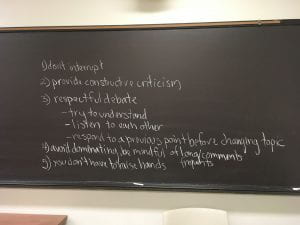I am curious what everyone’s thoughts are on synchronous and non-synchronous course elements–and for different sorts of texts. This week was the first time I have experienced a large group meeting over Zoom, and I have to say, I did not find it boring. If anything, the many modes of interaction were a bit overstimulating. I felt distracted. I had the sense (as our students might) that everyone was moving much faster with the tech than I could. I had the sense I was missing things while fiddling with how to make other things happen. But we, and the students, will figure these things out over time, or figure out enough of them that we can communicate.
A question for us in the humanities–especially those teaching writing intensive core courses–might be: Can we leverage this unexpected communication situation, in which many of us will be winging it, to demonstrate something valuable about our very content? I’m thinking loosely here of Derrida on speech and writing. Do we need to try to substitute the immediacy of speech and presence with its technological equivalent? Is there something to be said here, instead, for writing–for that communication that needs to more robustly stand on its own? And can we make a pedagogical virtue of this?
We ought to consider that the students will be taking 3 or 4 courses and it really is too much to expect them to perch in front of a Zoom screen for hours upon hours every day. And we are asked to consider that for some, our class times might be in the middle of the night for them. Many will not be in optimal learning environments–for all sorts of reasons from being at home with their families to living in remote locations with slow internet, etc. For these reasons alone, some kind of shortened synchronous session would be appropriate. I am thinking about reducing the synchronous time to 40 or 50 minutes.
One idea about preparing the students for those 40 or 50 synchronous minutes is to ask reading questions and have them work in groups to put answers together in shared Google documents. They could do this without being available at the same times–as long as everyone adds to or edits their group’s document. This way, they would be working collaboratively and a-synchronously on parts of the text that would also be the focus of the shortened session. And part of our synchronous time would be about their coming together aurally (and visually) to discuss the documents thus created. It may turn out that they are teaching themselves and each other the things I most want them to know. It may be that navigating amongst themselves is more useful than waiting for me to lead them. It may be that they will learn something about communicating from afar (about writing) by working with each other on the google docs and then coming back to the group.
Do others have thoughts about this? What percentage of class time do you imagine conducting synchronously? And do you have thoughts about making non-synchronous class time different in a meaningful way from what we would conventionally call homework?



Given most are stuck somewhere, somewhat alone or with the same few people, I imagine both the synchronous and the schedule could be valuable. Apparently a Zoom meeting can have breakout groups (I will learn about this later today), so you can pair students off to work together on whatever project you assign, then return later that session or, if you have shortened it, in a subsequent one. Thoughts?
I’m hopeful about the Zoom groups too. I have had one experience where breakout groups worked, and another (during the university’s Zoom training) where it didn’t. So, 50% success so far. Let us know how it goes in your training session?
A connected issue–besides internet bandwidth available to the students–is time zones. If students are across the globe, our neatly scheduled midday classes might be in the middle of the night for some of them. That’s where I’m thinking not-necessarily-synchronous platforms like Google docs might come in handy?
Having a google doc open even while doing a zoom session is a good idea too, to have another channel open in case the zoom conversation breaks down or to use as a whiteboard.
One piece of advice was to send out a survey to all students to see what time zones they are in, what quality streaming service they have, and what kind of device they are on (among other questions), so you can tailor your methods accordingly.
We tried breakout groups. It worked. We were told the host can go in and out of different groups, and send out messages to all at once, but we were not shown how.
There is a Zoom test site where you can practice its capabilities (www.zoom.us/test). I am also planning to do a few trial zoom sessions with colleagues, take turns hosting and managing.